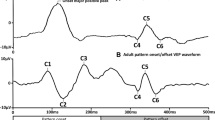Abstract
Pattern reversal visual evoked potentials (VEPs) were recorded from 38 patients with lesions affecting the chiasmal area. Lesions were confirmed by computer tomography and all patients had ophthalmologic examination. VEPs to full-field stimulation (0–16° r) were compared with those obtained with half-field stimulation.
Changes in VEPs were seen as a nonrecordable or attenuated P 100 (abnormal amplitude ratio) or as a prolonged P 100. Analysis of the records showed that temporal half-field stimulation (crossed fibers) yielded a higher rate of abnormal responses (80%) than full-field stimulation (66%). The most frequent abnormality in the former stimulation was a nonrecordable P 100 (42%) and in the latter an abnormal amplitude ratio of P 100 (41%). When the uncrossed fibers were stimulated with the nasal half-field, abnormalities were detected in 32% of responses.
Lesions in the region of the sella turcica were also associated with a high incidence of delayed responses (39% of patients when crossed fibers were stimulated). However, the magnitude of the delays was smaller (1–32 ms) compared with delays in patients with demyelinating disease.
Findings of this study show that half-field stimulation assists in the interpretation of responses to full-field stimulation. In addition, half-field stimulation can reveal abnormalities that are not detected with full-field stimulation.
Similar content being viewed by others
References
Halliday AM, Halliday E, Kriss A, McDonald WI, Mushin J. The pattern-evoked potential in compression of the anterior visual pathways. Brain 1976; 99: 357–74.
Haimovic IC, Pedley TA. Hemi-field pattern reversal visual evoked potentials. II. Lesions of the chiasm and posterior visual pathways. Electroencephalogr Clin Neurophysiol 1982; 54: 121–31.
Maitland CG, Aminoff MJ, Kennard C, Hoyt WF. Evoked potentials in the evaluation of visual field defects due to chiasmal or retrochiasmal lesions. Neurology 1982; 32: 986–91.
Onofrj M, Bodis-Wollner I, Mylin L. Visual evoked potential diagnosis of field defects in patients with chiasmatic and retrochiasmatic lesions. J Neurol Neurosurg Psychiatry 1982; 45: 294–302.
Holder GE. The effects of chiasmal compression on the pattern visual evoked potential. Electroencephalogr Clin Neurophysiol 1978; 45: 278–80.
Gott PS, Weiss MH, Apuzzo M, Van Der Meulen JP. Checkerboard visual evoked response in evaluation and management of pituitary tumors. Neurosurgery 1979; 5: 553–8.
Flanagan JG, Harding GFA. Multi-channel visual evoked potentials in early compressive lesions of the chiasm. Doc Ophthalmol 1988; 69: 271–88.
Müller-Jensen A, Zschocke S, Dannheim F. VER analysis of the chiasmal syndrome. J Neurol 1981; 225: 334–40.
Staudacher Th., Reuther R, Rittmann M, Krastel H. Die Wertigkeit der visuell evozierten Potentiale (VEP) bei Kompression der vorderen Sehbahn, speziell in der Chiasmaregion. Nervenarzt 1985; 56: 560–1.
Halliday AM. The value of half-field stimulation in clinical visual evoked potential testing. In: Morocutti C, Rizzo PA, eds. Evoked potentials: Neurophysiological and clinical aspects. Amsterdam: Elsevier Science Publishers BV, 1985; 293–313.
Blumhardt LD. The abnormal pattern visual evoked response in neurology. In: Halliday AM, Butler SR, Paul R, eds. A textbook of clinical neurophysiology. Chichester, New York, Brisbane, Toronto, Singapore: John Wiley & Sons, 1987; 307–43.
Lennerstrand G. Visual recovery after treatment for pituitary adenoma. Acta Ophthalmol (Copenh) 1983; 61: 1104–17.
Author information
Authors and Affiliations
Rights and permissions
About this article
Cite this article
Brecelj, J., Denišlič, M. & Škrbec, M. Visual evoked potential abnormalities in chiasmal lesions. Doc Ophthalmol 73, 139–148 (1989). https://doi.org/10.1007/BF00155032
Accepted:
Issue Date:
DOI: https://doi.org/10.1007/BF00155032




